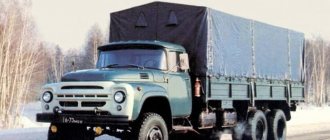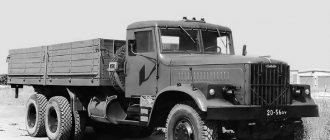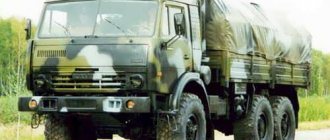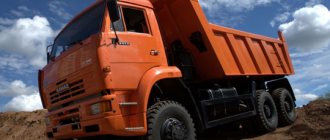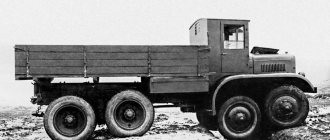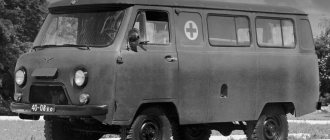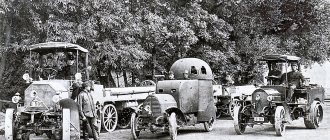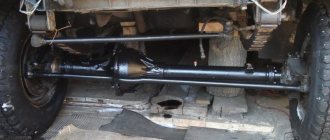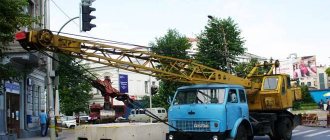ZIL-4334 Dimensions Fuel consumption Load capacity Tank volume
ZIL-4334, all-wheel drive truck. Until 1980, development work was carried out at ZIL to create a new family of ZIL-132 vehicles based on the ZIL-131N model; soon the engineers were switched to designing a new ZIL-4334 truck. The ZIL-4334 family includes two basic vehicles: the ZIL-433420 flatbed truck and the ZIL-433422 multi-purpose chassis.
Technical characteristics, design
The main workforce is hidden in the M8 series engine. It is capable of developing power equal to 170 horsepower. The use of an overhead valve cooling system is typical. 90 kilometers per hour is the maximum speed that technology can develop.
Thanks to its power, the equipment easily overcomes obstacles:
- Climbing on a hard road, with a slope of up to 35 degrees.
- 1.4-meter obstacles on the water.
The power unit is complemented by a 5-speed manual transmission. The main mechanisms also include a two-stage transfer case. ZIL 433420 also has these parts. 24 Volts is the standard power for electrical equipment for all types of modifications. A generator with two batteries is the main source of electricity. The quality of connections, electrolyte level are the minimum parameters that require checking for stable operation of the electrical circuit.
Be sure to read: Gas 66
The status of the following main parts is recorded on the dashboard:
- Generators.
- Brakes.
- Air pressure and so on.
8mm side members complement the main frame. They determine some technical characteristics of ZIL 4334.
The clutch organizes the connection of the motor with other components of the system.
The design of this part also includes several parts:
- Springs with peripheral location.
- Pneumatic booster.
- Hydraulic pipeline. The Kung series also has it.
All speeds are synchronized with each other, the first is the only exception. The drive of the three axles is controlled by the transfer case. Two speeds cannot turn on at the same time, because the design also comes complete with a ball-type locking mechanism. Independent suspension with wheels contributes to high maneuverability.
The truck is used in various services
About standard equipment
It was she who appeared on the market first. All other options were developed after some time. Modifications also affect what the price of the ZIL 4334 will be.
About the cabin and external equipment
The standard equipment includes a three-seater cabin, which is quite spacious and comfortable.
There are two additional nodes associated with this location:
- Hydraulic shock absorber.
- Own pendant.
The seat position for drivers can be adjusted in several ways:
- Height.
- Distance between steering wheel and levers.
- Hardness, specific degree. Firefighters ZIL 4334 were no exception to the rule.
Each cabin can be perfectly adjusted to the individual characteristics and dimensions of a person. Height and angular adjustment of the steering wheels does not cause any trouble.
Heat and sound insulation, heating and ventilation are the points to which engineers paid the most attention. Characterized by a rational, convenient arrangement of all control-related devices. The built-in heating system protects the mirrors from condensation at any temperature. Thanks to videos on the Internet, there are no problems when studying the characteristics of a car.
The wings and hood are made as a single unit. This makes access to the units from the power plant easier. The front part of the frame can be equipped with a special winch. Its traction force reaches 5 kilograms under various conditions. Photos on the Internet confirm this possibility.
Be sure to read: Technical characteristics of Gazelle Business UMZ-4216
Units and assemblies
Trucks are equipped with the following types of devices:
- Frame with side members reinforced to 8 mm.
- Transfer case, two-stage.
- Reinforced manual gearbox. A manipulator can be added if desired.
A self-steering system monitors the axle ahead. Using zero gear results in independent shifting. The front axle assumes forced engagement when the road section is slippery. There is a special switch on the panel that closes the circuit. This is how any military ZIL 4334 works. Special hatches are involved in the installation of power take-off devices.
ZIL has good off-road capability
The equipment is equipped with three bridges, all of them are driving. The middle axle is the only intermediate part, its strength is needed to complement the rear axle. Drive axles increase the possible load if forced force is taken.
Load capacity
It is equal to 4000 kilograms in any conditions. Buying a car from storage is not difficult.
Analogs
There are two main versions of ZIL-4334 available. We are talking about a flatbed truck and a model with which various add-ons can be easily mounted. Standard cabins are three-seater, but they can be made into 7-seaters.
By the end of 2015, there were already 4 modifications on the market, two of them with a gasoline engine, and two more with a diesel engine. There were separate fire tanks with approximately the same characteristics. The dump truck also included other modifications.
ZIL-4334 - video of pulling out a stuck truck
The vehicles are equipped with a multi-fuel V-shaped eight-cylinder diesel engine ZIL-6451 with a power of 170 hp. p., 10-speed transmission, tire pressure regulation system, cable winch, engine preheater. Off-road vehicles can transport 3.75-4.45 tons of cargo. The AR-2-61VR hose truck was created on the ZIL-4334 chassis, designed to equip fire departments with hoses when extinguishing large fires, as well as the ATs-3.0-40-3VR fire-fighting tank truck. Cars with a 6x6 wheel arrangement are equipped with a 150 hp engine. With. and accelerate to a maximum speed of 80 km/h.
Prototypes for Moscow
When designing fire-fighting tankers, of course, it was not possible to do without prototypes and design options. Some samples have been preserved not only in photographs, but also in metal. As a rule, experimental machines underwent controlled operation in the control centers of Moscow and the region. The vehicles were repeatedly returned to the factory for repairs, some remained forever, and many are still in combat service.
"Unnoticeable" project
In 2008, the Moscow Automobile Plant named after. Likhachev with the financial and moral support of the Moscow government represented by Yu.M. Luzhkov took on the project of an armored all-wheel drive (4x4) multi-purpose vehicle with a carrying capacity of 2.5 tons for special forces of the armed forces and law enforcement agencies (riot police force, FSB, etc.). It was necessary to create a vehicle that, on the one hand, would be as simple and technologically advanced as possible, with an abundance of flat surfaces that simplify armoring, and on the other hand, should have external shapes “with individual expressiveness” to emphasize its purpose.
The design project of the new car, a little similar to the legendary ZIL-131, was proposed by Lev Samokhin. During the development of the preliminary design in August–October 2008, a landing model was built. In terms of the layout of the main units, this machine did not differ from similar designs of others (IVECO-LMV, etc.) and was as close as possible to the production capabilities of the plant itself. Meanwhile, the project had one “highlight” - one of the options for the layout of the internal space provided for the placement of fighters with their backs to each other and facing the windows. This makes it easier to conduct all-round surveillance from a car and shoot from personal weapons. Soon this idea will become the main one, and all subsequent options will be created around it.
In Lev Samokhin's project, back-to-back landings have already been implemented
In an attempt to give new properties to a promising machine, a desire arose to create something fundamentally new. One of the priority areas was the “stealth” of the vehicle for destruction weapons. In this regard, new requirements for the car arose: minimal dimensions and a low silhouette (the smaller the object, the more difficult it is to get into it); radio transparency (shielding and the use of radio transparent composite materials); minimal heat generation and low noise (use of a hybrid power plant), etc. All these ideas directly intersected with Stealth aviation technologies, therefore, the car needed to be given the appropriate shape.
At this stage, a new design project appeared, completed in the Sahakyan-Design studio by Svyatoslav Sahakyan and Andrey Chirkov. It is based on the concept of Konstantin Potekhin and the general layout developed by the deputy director for development of AMO ZIL - project manager of the engineering company Sergei Oshurkov. The layout and placement of the units was carried out by leading design engineer Andrey Stepanov. The administrator and driving force of the entire project was the deputy chief designer of ZIL, Vladimir Grigorievich Mazepa.
View of the salon through the aft doorway
Aft doors from the saloon closed
On the front panel there are front and rear camera monitors
Front view cameras are hidden in the front of the car
The new project captivated everyone with its unusualness and originality, despite some obvious design flaws, and soon became dominant. Work on the first car based on Samokhin’s project was not abandoned, but was carried out in parallel, starting with the construction of a chassis with an original independent wishbone suspension with air springs.
On the ZIL-5301 chassis
The early experimental Zilov model with the original radiator lining, overhead expansion arches of the openings above the front axle wheels, block headlights in the bumper, low superstructure, and hinged “pantry” compartment doors did not participate in exhibitions. Used as an escort vehicle during trips to Bronnitsy for testing. The original radiator lining appeared in 2004 with the start of mass production of fire engines of the Euro 2 environmental class. The additional radiator of the pressurization system did not fit in the old lining. UKER did not support the designers' proposal, but solved the problem by removing the amplifiers on the inside.
